Alex and Charlie have been together for a year, but they attend different high schools. Every morning before school, Alex asks Charlie to send them pictures of how they are dressed to make sure it is acceptable. One morning, Alex did not like the black jeans that Charlie was wearing because they made them look too attractive. Alex tells Charlie, ‘You’re going to wear that to school? Are you trying to get someone else’s attention? They're too tight.’. Charlie apologizes and goes to change their outfit before going to school.
Adolescence is a period of transition when adolescents experience a lot of changes, including, for many, the start of their first romantic relationships1. Navigating these romantic relationships is new and often poses challenges. Adolescents often face more conflicts than adults, as they are learning the different skills (e.g., emotional regulation, problem solving) necessary to successfully navigate these new intimate relationships2,3. Adolescents may also resort to coercive and violent tactics, like control, to try to influence their partner’s behaviours.
What is control?
Control in romantic relationships is a form of violence used by an individual to alter a partner's behaviours and beliefs. Control often stems from insecurity, possessiveness, and a desire to maintain dominance in the relationship4,5,6. It can manifest in both overt and subtle ways, making it crucial to better understand its various manifestations. In a study conducted by the Laboratory for the Study of the Well-being of Families and Couples, the different control tactics used by adolescents in their dating relationships were analyzed. Two main tactics were identified:
1. Isolation is when your partner tries to distance you from your support system (i.e., family and friends) to increase your vulnerability and dependence on them.
2. Domination is when your partner imposes their view on your personal decisions, ultimately leading you to question your choices, beliefs, and identity.
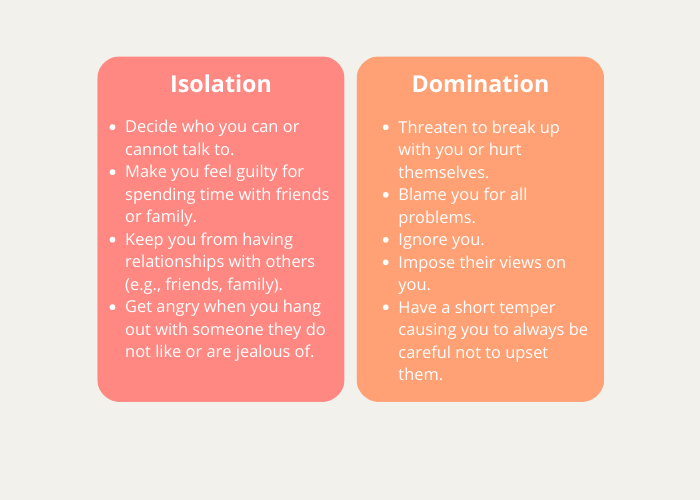
Recognizing control in your relationship
Alex dictating the way Charlie dresses is an example of how control can manifest in a relationship. A partner may use a variety of control strategies in order to get their partner to modify their behavior or to instill doubt in them.
If you recognize yourself in this scenario, try to think about how this type of behaviour impacts you or your relationship. You can discuss with your partner healthier ways to express your needs in the relationship while respecting those of your partner. If the controlling behaviours continue or escalate to other forms of violence (e.g., sexual, physical), consider discussing with a trusted adult or professional the best course of action.
Is control common in adolescent relationships?
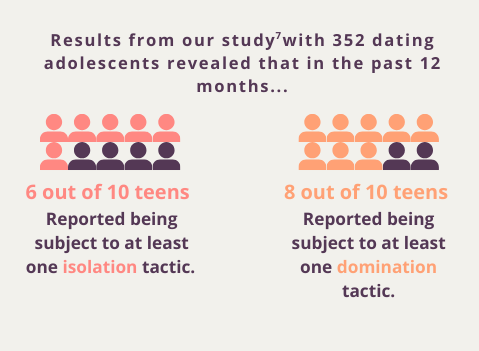
These results7 show just how common control is in adolescent relationships. Control is often normalized. In this regard, nearly one in three adolescents mistakenly believes that it is an inevitable aspect of dating relationships that allows them to prove their commitment, love, and trust towards their partner8,9. This normalization is dangerous as many adolescents do not realise that control can have negative effects on their well-being.
Why is it important to address control in romantic relationships?
Our team conducted interviews with 39 adolescents in a romantic relationship. The data revealed the detrimental effects control can have on oneself and on relationships:
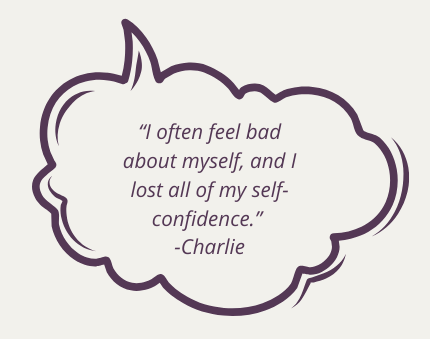
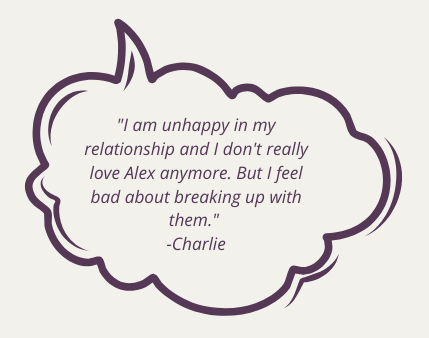

Furthermore, the stress and emotional turmoil resulting from control can hinder academic performance, having a negative impact on the educational journey of many victims. Control may also escalate to the use of other forms of violence (e.g., physical, psychological, or sexual) when strategies are not successful in maintaining power or getting a behavioural change out of a partner10,11. Experiencing control may lead survivors to fear their partner and constantly feel as though they are walking on eggshells, for example, trying not to let their partner down, make them angry or avoid starting a conflict12.
Identifying and addressing these subtle controlling behaviours
If, like Charlie and Alex, you or a friend have experienced control tactics in your relationship, here are a few recommendations to help you:
- Recognize the signs of control: If you or your partner tries to isolate one another from their friends and family or makes the other person question their personal decisions, behaviours, or values, know that these may be controlling beahviours.
- Trust your instincts: If you feel uncomfortable or do not feel free in your relationship, know that your feelings are valid.
- Prioritize your well-being: If you feel that you have stopped doing things that used to bring you pleasure since you've been in this relationship, we encourage you to participate in activities that make you happy, contribute to your sense of self-esteem, and promote your well-being.
- Set boundaries: If you do not feel respected in your relationship, establish clear personal boundaries and communicate them to your partner. If the response to your attempts to set boundaries is not satisfactory, it would be appropriate to ask yourself whether it's worth continuing this relationship or not. When your partner sets boundaries, make sure to respect them.
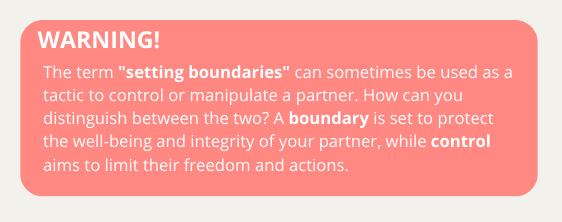
- Communicate openly: If you are not satisfied in your relationship, express your needs and concerns regarding your relationship to your partner, friends, or any other trusted person.
- Build a strong network of positive support: Try to nurture current positive relationships by investing time and effort into them. If you have isolated yourself and lost certain relationships, attempt to reach out and slowly rebuild. If you do not have many people around you, try to seek out like-minded people by joining clubs, communities, or groups that share the same interests and values as you.
- Seek support or assistance from professionals: If you do not feel safe in your relationship, consider seeking help from a professional by referring to the list of resources mentioned below.
- Additionally, if you find yourself using control strategies towards your partner, consider seeking help from a professional or talking to a trusted person in order to find alternatives to meet your needs in the relationship while respecting your partner.
The publication of this article was made possible thanks to our partner, the Interdisciplinary Research Centre on Intimate Relationship Problems and Sexual Abuse (CRIPCAS), and the Fonds de recherche du Québec.
Resources
- Tel-jeunes - Phone: 1-800-263-2266; Text : 514-600-1002
- Kids Help Phone- Phone : 1-800-668-6868; Text : Text CONNECT to 686868
- It's not violent… or is it? S.O.S. Dating violence awareness campaign
- La violence conjugale
- Campaign in french to raise awareness of sexual violence in intimate settings: an initiative WITH, BY and FOR teenagers⋅e⋅s
- Étincelles – Additional information on dating violence
- LÉFAC- Infograhics on relationships and dating violence
- LabEVS - Additional information on violence in romantic relationships.
- Seek help from your school counselor
- 1Gómez-López, M., Viejo, C., & Ortega-Ruiz, R. (2019). Well-Being and romantic relationships: A systematic review in adolescence and emerging adulthood. International Journal of Environmental Research and Public Health, 16(13), 2415. https://doi.org/10.3390/ijerph16132415
- 2Cascardi, M., & Avery-Leaf, S. (2015). Gender differences in dating aggression and victimization among low-income, urban middle school students. Partner Abuse, 6(4), 383–402. https://doi.org/10.1891/1946-6560.6.4.383,
- 3Lantagne, A., & Furman, W. (2017). Romantic relationship development: The interplay between age and relationship length. Developmental Psychology, 53(9), 1738–1749. https://doi.org/10.1037/dev0000363.
- 4Ferriani, M.G.C., Campeiz, A.B., Martins, J.E., Arag.o, A.S., Roque, E.M.S.T., & Carlos, D.M. (2019). Understanding and contextualizing teen dating violence. Escola Anna Nery, 23(3),1-9. https://doi.org/10.1590/2177-9465-ean-2018-0349
- 5Brem, M. J., Shorey, R. C., Rothman, E. F., Temple, J. R., & Stuart, G. L. (2018). Trait jealousy moderates the relationship between alcohol problems and intimate partner violence among men in batterer intervention programs. Violencea Aainst Women, 24(10), 1132–1148. https://doi.org/10.1177/1077801218781948
- 6Rodriguez, L. M., DiBello, A. M., øerup, C. S., & Neighbors, C. (2015). The price of distrust: Trust, anxious attachment, jealousy, and partner abuse. Partner Abuse, 6(3), 298–319. https://doi.org/10.1891/1946-6560.6.3.298
- 7De Sousa, D., Fortin, A., Fernet., M., & Paradis, A. (2023). Development and validation of the Control in Adolescent Dating Relationships (CDRS) [Manuscript in preparation]. Department of psychology, Université du Québec à Montréal.
- 8Catallozzi, M., Simon, P. J., Davidson, L. L., Breitbart, V., & Rickert, V. I. (2011). Understanding control in adolescent and young adult relationships. Archives of Pediatrics and Adolescent Medicine, 165(4), 313–319. https://doi.org/10.1001/archpediatrics.2011.32
- 9De Miguel, V . (2015). Percepción de la violencia de género en la adolescencia y la juventud [Perceptions of gender-based violence among adolescents and youth]. Madrid: MSSSI.https://violenciagenero.igualdad.gob.es/violenciaEnCifras/estudios/investigaciones/2015/pdf/Libro20_Percepcion_Social_VG_.pdf.
- 10De Sousa, D., Paradis, A., Fernet, M., Couture, S., & Fortin, A. (2023). "I felt imprisoned": A qualitative exploration of controlling behaviors in adolescent and emerging adult dating relationships. Journal of Adolescence, Advance online publication. https://doi.org/10.1002/jad.12163
- 11Fawson, P. (2015). Controlling behaviours as a predictor of partner violence among heterosexual female and male adolescents. Partner Abuse, 6(2), 217-229. https://doi.org/10.1891/1946-6560.6.2.217
- 12Conroy, N. E., & Crowley, C. G. (2022). Extending Johnson’s typology: Additional manifestations of dating violence and coercive control. Journal of Interpersonal Violence, 37,15–16. https://doi.org/10.1177/08862605211005149.










